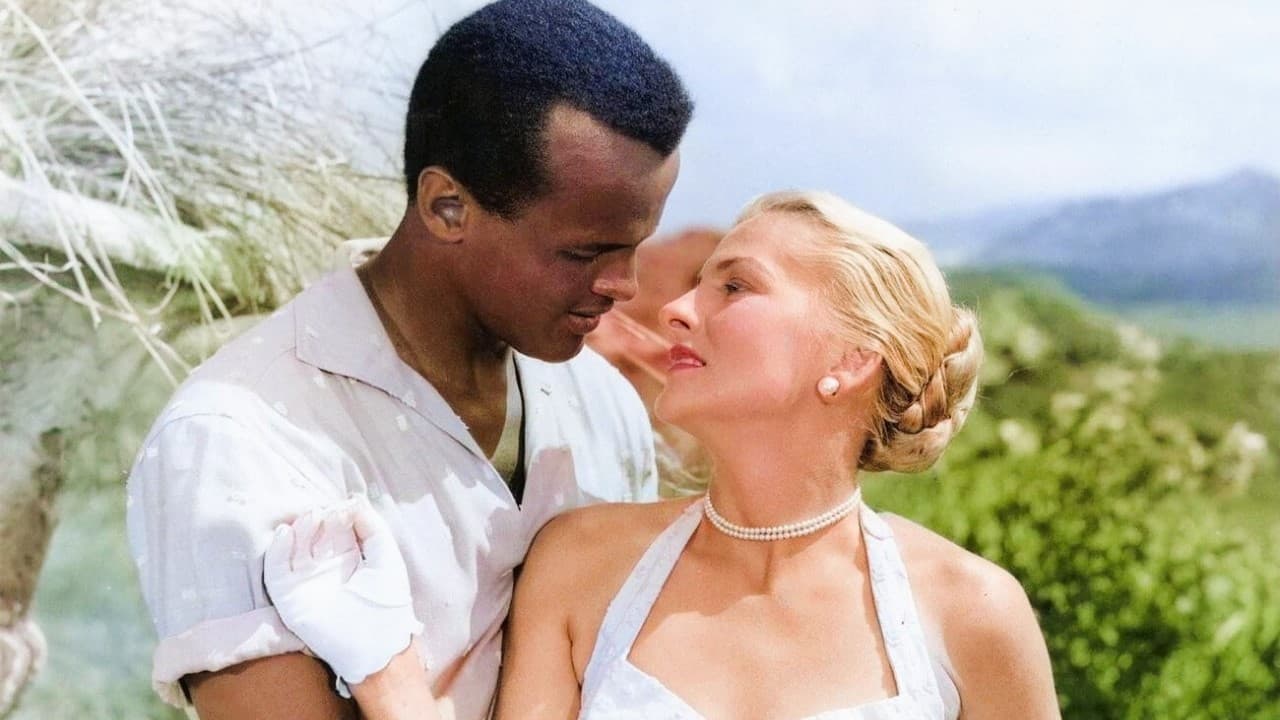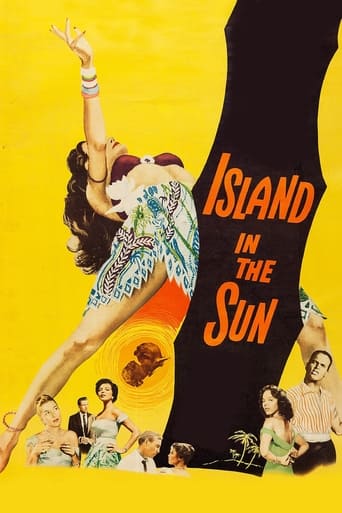Incannerax
What a waste of my time!!!
Fairaher
The film makes a home in your brain and the only cure is to see it again.
ChanFamous
I wanted to like it more than I actually did... But much of the humor totally escaped me and I walked out only mildly impressed.
Lollivan
It's the kind of movie you'll want to see a second time with someone who hasn't seen it yet, to remember what it was like to watch it for the first time.
HotToastyRag
When Harry Belafonte sings the title song during the opening credits, you think you're in for a relaxing film about island life. The cast list might give you a little clue, though. Would Harry Belafonte, Dorothy Dandridge, James Mason, Joan Fontaine, Stephen Boyd, Joan Collins, and Michael Rennie all come together for a comedy? Island in the Sun is a heavy, melodramatic movie, reminding me of the types of films Otto Preminger directed.Rife with racial tensions, the "island in the sun" is far from a paradise. James Mason has a strained marriage with Patricia Owens, who seems to have developed a fondness for Michael Rennie. Stephen Boyd, a politician's young son, comes to the island on vacation, but he falls for James's sister Joan Collins and considers staying permanently. Harry Belafonte is friends with Dorothy Dandridge, but neither one is accepted by white society, so as much as they become "friends" with Joan Fontaine and John Justin, respectively, they're still involved in the great simmering social battle across the island.Island in the Sun sounds really good, promising to be another Hurry Sundown or Pinky, but it becomes enormously predictable towards the end. There are many promising scenes that make you sigh by the time they reach their conclusions. Maybe if Hollywood waited ten years, the movie would have pushed more boundaries or felt a little racier, no pun intended. As it is, it feels a little watered down, as if the final version was severely censored.
tomsview
I first saw this at the cinema in 1957. I was young and probably didn't fully appreciate the issues the film dealt with, but over the years I realised that it was an important film that had something to say about race relations.With Barbados standing in for the fictional Santa Marta in the West Indies, the plot centres on the Fleury family - Maxwell Fleury (James Mason) and his sister Jocelyn (Joan Collins). Other characters and relationships weave through the story including the ones between David Boyeur (Harry Belafonte) and Mavis Norman (Joan Fontaine) - black boy, white girl - and Denis Archer (John Justin) and Margot Seaton (Dorothy Dandridge) - white boy, black girl.The crux of the story is the inequality between the white establishment and the native population descended from African slaves or of mixed race - 'the colour problem'. But times are changing and the native population is gaining political power.Maxwell Fleury, who represents the white patrician families of the island, becomes paranoid over just about everything, especially when he learns that a mixed-race grandmother crept into his family tree.The film features four actors with great presence: Harry Belafonte, James Mason, Michael Rennie and Steven Boyd, and four actresses so striking it's almost overload: Joan Fontaine, Patricia Owens, Joan Collins and Dorothy Dandridge.The film was a daring decision by Daryl Zanuck at the time. It dealt with race issues that were boiling to the surface in the 1950's and would boil over in the 1960's and regularly thereafter. Director Robert Rossen tackled the issues head on - the last conversation between David Boyeur and Mavis Norman expressed uncomfortable truths.However, this good-looking movie with its good-looking cast also had to work as entertainment, and it does from the opening frame as Harry Belafonte sings the brilliant title song, which he also co-wrote. The song gave composer Malcolm Arnold something to build the score of the film around. Although Arnold was a fine composer for the concert hall, much of his film work sounded the same. Belafonte 's title song and "Lead Man Holler", which he sang later, lifted Arnold's score from his usual by-the-numbers approach.Other films at the time were also focussing on the race issue, but this one went closest to the bedroom. Although the interaction between the sets of interracial lovers stopped short of a passionate kiss, "Island in the Sun" otherwise didn't hold back on what it had to say.
vincentlynch-moonoi
The first issue I had was James Mason. When I was young I thought he was a very good actor. And sometimes he was. Perhaps it was that wonderful voice. In recent years I've taken a second look at Mason's work, and I'd have to say his performances were rather uneven, and in my view his performance here was horrid. Maybe it was the director, or maybe it was the way Mason interpreted his character, but petulance did not fit here, and for much of the first half of the film, that's what Mason's character was -- petulant.The second issue was Dorothy Dandridge. I knew of her, but I'm not sure I ever saw her in another film. Perhaps. But, if this is an example of her at her best, then I'm not impressed. Although, she was remarkably beautiful.A third issue was Joan Collins. Now I enjoyed her in "Dynasty", but that doesn't mean I thought she was a good actress. She knew how to look seductive and sexy. But she didn't know how real people talk or behave, and it certainly shows here.A fourth issue was transitions from one setting/scene to another. Sometimes they seemed awkward, as if the scene wasn't really quite finished, even though it had ended.A fifth issue was the dialog. It was mostly okay, but occasionally it seemed to misfire. For example, the car has been sabotaged with the rotor taken out, and the response is, "It can't be a coincidence." Well, duh! And then there's Joan Fontaine's apparel. Just seemed a little too "white" in a film about interracial love affairs. Over done.So you might think I didn't like the film. Well, despite all the issues, overall I thought it was quite good. First of all, for 1957, interracial romance was a hot topic. This film took courage, particularly for Joan Fontaine.This was more an ensemble cast than a star vehicle. So, I enjoyed seeing Michael Rennie, an actor that I always felt was underestimated. John Justin was quite good. Stephen Boyd was sounding VERY British here, but he played the part nicely. Diana Wynyard, as the mother with a secret, has one exceptional scene when she finally tells her daughter a truth; this was her final film. John Williams always played a wonderful detective (as in "Dial M For Murder); a treat to see him in the same type of role here! I also enjoyed Ronald Squire.In case you think I forgot Harry Belafonte, no, I didn't forget. I just don't think of him as an actor.Despite some real issues, I liked the film. It has a strong plot, is lavishly produced with beautiful settings, and its theme is still very timely...amazing after nearly 60 years!
edwagreen
Disappointing film dealing with life in the Caribbean.The film might have fared better if it had been a musical. The movie marked the re-teaming of Harry Belafonte and the late Dorothy Dandridge from "Carmen Jones" fame 3 years before. Belafonte sings well at the beginning before this film evolves into too many plots, pregnancy, murder, racial tension, politics, etc. The subject matter is totally uneven and the film suffers as a result. Dandridge was never weaker before in any of her brief film career. She evokes little to no emotion and the luster of Carmen, 3 years before, is totally gone.There is entirely too much going on here. James Mason is caught up in a killing, running for political office, and facing the reality that he is partially black. Belafonte loves Joan Fontaine, of all people, but by the end can't marry her due to racial-political considerations on the island. Joan Collins loves Stephen Boyd, he is given so little to do here, but he will be in The House of Lords, so how can she marry him if their children might be black. (Collins and Mason are brother and sister in this Peyton Place circus-atmosphere.) To complicate matters still further, old timer Diana Wynyard, an Oscar nominee for 1933's "Cavalcade," appears in the film as the mother of Collins and Mason. She is effective in the part but the plot twists again when it is revealed that she had Collins from another man.Robert Rossen who directed this mess, did so much better years before with his winning "All the King's Men." That 1949 Oscar winner for best picture stuck with basically one theme. This one is all over the mull berry bush.

